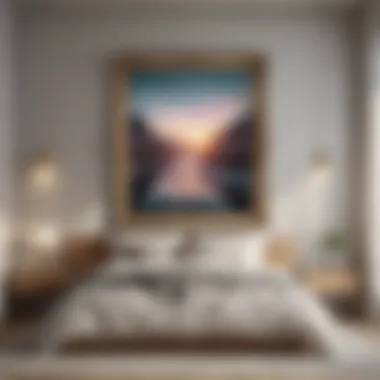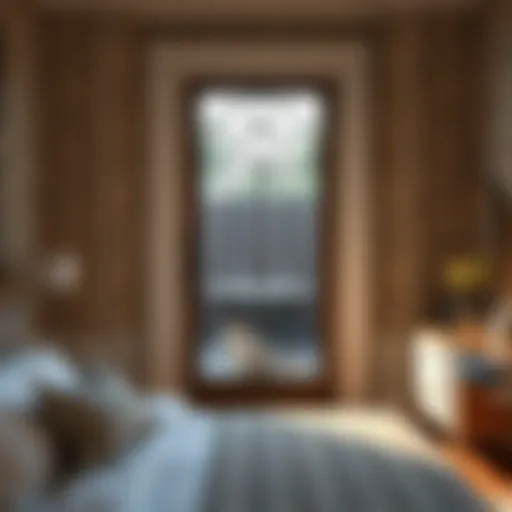Relaxing Artwork for a Serene Bedroom Retreat


Intro
Creating a calming atmosphere in the bedroom is paramount for overall well-being. The right artwork can play a significant role in achieving this sense of tranquility. Selecting the appropriate pieces can enhance the serenity of a space, offering a refuge from the outside world. This guide will explore various styles of relaxing artwork and how to position it effectively to maximize its calming influence.
Trending Styles
Art styles can vary immensely, but some styles tend to evoke a stronger sense of peace and comfort. Below are two prominent styles that may suit a tranquil bedroom environment.
Modern Minimalism
Modern minimalism is characterized by simplicity and clean lines. This style avoids clutter and overly complex designs. In a bedroom, minimalistic artwork can create an environment of calmness and clarity. Look for geometric shapes or monochromatic pieces that use soft colors. Artworks in this style help to minimize distractions and promote a sense of focus.
Cozy Rustic
Cozy rustic artwork embraces natural elements and textures. Think of landscapes, botanical prints, or soft pastel colors. These pieces often draw on organic imagery and earthy tones, offering a warm and inviting aesthetic. This style resonates with nature, allowing one to feel connected with the outdoors. Incorporating rustic art can create a homey feeling, enhancing relaxation and comfort in the bedroom.
Color Palettes
The colors used in artwork can have profound psychological effects. Choosing soothing colors can further enhance the tranquil vibe of the bedroom. Here are two effective color palettes to consider.
Calming Neutrals
Neutral tones like beige, soft gray, and gentle ivory are excellent choices for relaxing artwork. They serve as a soothing backdrop that can help create a serene environment. They are versatile and can blend seamlessly with various decor styles. These soothing hues can induce a feeling of peace and stability, making them ideal for spaces meant for rest.
Bold Accents
While neutrals are calming, bold accents can add character without overwhelming the senses. Colors such as deep blue or muted greens can create focal points without becoming intrusive. A single bold artwork can serve as a conversation starter while still maintaining a generally serene atmosphere. When used thoughtfully, these colors can bring a balance of energy and calm to the space.
"The choice of artwork can be both a personal expression and a tool for enhancing one’s environment."
Understanding the Role of Artwork in Bedroom Design
Artwork plays a crucial role in defining the overall ambiance and functionality of a bedroom. This personal space serves as a sanctuary for rest and rejuvenation, and the right visual elements can profoundly affect one's emotional state. By incorporating thoughtfully chosen artwork, homeowners can transform a standard room into a relaxing retreat that promotes serenity and well-being. It is essential to recognize that artwork is not simply decorative; it conveys feelings, communicates personal values, and reflects individual taste. Therefore, the selection process should be approached with care and intention.
In particular, the visual art in a bedroom can serve multiple functions. It can act as a focal point, draw attention to specific areas, or provide a backdrop that inspires calmness. The art selections must resonate well with the color scheme, furniture, and lighting. Each element must work together, creating a conducive environment for rest.
Additionally, the importance of art in the bedroom extends beyond aesthetics. Engaging with art can have therapeutic benefits. Studies have shown that viewing visually appealing pieces significantly uplifts one's mood. Therefore, diving into the psychological aspects of artwork can illustrate how particular visuals trigger relaxation and peace.
Ultimately, understanding the role of artwork in bedroom design is about creating a harmonious balance between beauty and functionality. Such a balance can yield a nurturing space that invites tranquility and restfulness, making it an essential focus for any homeowner looking to enhance their sleeping quarters.
The Psychological Impact of Visual Art
Visual art possesses an extraordinary power to influence emotions and thoughts. When it comes to bedroom design, the psychological impact of art cannot be overstated. Colors, shapes, and subjects within artwork can evoke a variety of feelings, and knowing how to harness this potential can elevate the sleeping experience.
For example, certain colors have been shown to elicit specific emotional responses. Cool tones, like blues and greens, are often associated with calmness and tranquility. In contrast, bright and vibrant colors tend to energize. Thus, for a bedroom environment aimed at relaxation, cooler palettes or soft pastels may enhance feelings of peace.
The subjects depicted in art also play a vital role. Natural landscapes or serene abstract pieces tend to promote feelings of relaxation. On the other hand, art that depicts busy urban scenes or chaotic imagery can create a sense of stress or overwhelm.
Furthermore, the size and placement of artwork can amplify its psychological effects. Large pieces can create dramatic focal points but may overwhelm if not handled appropriately. Conversely, a thoughtfully placed smaller piece can bring attention to desired areas without dominating the space.
"Art is the most beautiful of all lies."
Such a sentiment underscores the importance of understanding art's psychological influence in crafting a soothing bedroom experience. Through intentional selection, homeowners can curate spaces that align with their emotional needs and promote overall well-being.
Creating a Calming Atmosphere
A calming atmosphere is fundamental to a restful bedroom, and artwork plays a central role in establishing this environment. The careful selection and placement of art can set a serene tone, ensuring the space becomes a refuge from the stresses of daily life.
One effective way to promote calmness is through color psychology. Utilizing soft hues aligns with the notion of certain colors providing tranquillity and relaxation. Beside choosing appropriate colors, it's equally important to consider the types of artwork.
Natural landscapes, such as tranquil seascapes or peaceful forests, can evoke feelings of serenity. Minimalist abstracts that employ gentle lines and shapes also contribute positively to a calm atmosphere. Through these visual choices, the bedroom can transform into a peaceful haven.


Moreover, the arrangement and positioning of art also have significant implications. Artwork positioned in direct line of sight from the bed can serve as a gentle reminder of tranquility each time you wake or retire. Resisting the urge to overcrowd the walls, a few choice pieces can be more impactful than a gallery of works.
Characteristics of Relaxing Artwork
Understanding the characteristics of relaxing artwork is crucial for creating a serene environment in the bedroom. The artwork one chooses can set the tone for the entire space and influence one's emotional state. Various factors such as color, subject matter, and texture play vital roles in how artwork affects the room's ambiance. By focusing on these elements, homeowners can enhance tranquility and establish a restful area suitable for relaxation and sleep.
Color Psychology and Its Effects
Color psychology significantly impacts mood and feelings. The colors in artwork can either uplift or calm, depending on their nature and hue. This section delves into specific color palettes that contribute to relaxation in the bedroom.
Warm vs. Cool Colors
Warm and cool colors evoke different feelings. Warm colors like reds and oranges can stimulate energy, while cool colors such as blues and greens promote calmness. In bedroom artwork, cool shades are often preferred. Their serene quality helps to lower heart rates and promote relaxation, making them a beneficial choice for relaxation. However, incorporating a few warm accents could create balance if needed, offering a gentle contrast.
Soft Pastels and Neutrals
Soft pastels and neutral tones provide a gentle influence in a bedroom setting. Shades like light pinks, blues, and creams create a soothing atmosphere. Their subtlety allows for easy integration into diverse decor styles without overwhelming the room. These colors are popular choices because they calm the spirit and mind. However, excessive use might lead to a lack of vibrancy, so balancing with deeper hues can be effective.
Use of Earthy Tones
Earthy tones connect individuals to nature, fostering a grounding effect. Colors like browns, greens, and terracottas create a cozy, organic feel in the bedroom. They often bring a touch of warmth and can enhance feelings of stability and peace. Earthy tones appeal to those seeking a connection to natural elements within their home. Despite their many benefits, using too dark shades might give a heavier feel, so moderation is key.
Subjects That Evoke Tranquility
Selecting subjects for artwork that evoke tranquility is essential for a calming environment. Artwork featuring peaceful themes can transport viewers to soothing places and encourage relaxation.
Natural Landscapes
Artwork depicting natural landscapes plays a significant role in relaxation. Scenes of mountains, forests, and bodies of water foster a connection to nature. This connection can shift focus away from daily stressors, enhancing the overall atmosphere in the bedroom. Natural landscapes are beneficial as they often elicit feelings of peace. However, the complexity of certain scenes can potentially create distractions if not chosen carefully.
Minimalist Abstracts
Minimalist abstracts promote a sense of spaciousness and clarity. These artworks often utilize simple shapes and limited color palettes to create a calm energy. Their lack of clutter allows the mind to relax and drift without focusing on detailed or overwhelming imagery. They are popular among those seeking simplicity in their design. However, some may view them as lacking depth or emotion.
Calm Figurative Art
Calm figurative art often portrays serene human figures engaged in peaceful activities. The representation of tranquility in poses can evoke similar feelings in viewers. Artwork in this category encourages individuals to embody relaxation. The advantage of calm figurative art lies in its ability to connect with viewers on a personal level. On the downside, overly busy or detailed figurative art can disrupt the serene atmosphere aimed for in a bedroom.
Texture and Material Considerations
Texture in artwork can also influence its calming effect. The materials used in artwork contribute to its overall feel and aesthetic quality.
Canvas vs. Print
Canvas artwork tends to impart an organic essence that can evoke a sense of warmth and authenticity. It has a three-dimensional texture that can create a more substantial visual interest in a room. Prints typically offer greater variety and precision in detail. Each type presents its own advantages; canvas may foster a more inviting ambiance, while prints can provide vibrant colors and detailed imagery.
Mixed Media Works
Mixed media artworks combine various materials and techniques, providing a unique texture and depth. They can introduce interest through their complexity. These pieces often incorporate elements that enhance the emotional response of viewers. Mixed media art is beneficial because it adds depth to the artwork while allowing room for creativity and uniqueness. However, over-complex designs can challenge the calming intention they may aim to achieve.
Soft Fabrics in Art
Soft fabrics used in art, such as textiles or tapestries, can introduce warmth and comfort. These pieces often soften the visual impact, providing an inviting feel to the bedroom. Soft fabric art encourages touch and interaction. However, its maintenance can be a challenge, as art made of textiles may require extra care to retain its serenity-enhancing qualities.
Selecting Artwork for Different Bedroom Styles
Selecting artwork for different bedroom styles is essential in creating a cohesive and calming environment. The art you choose reflects your personality and the overall aesthetic of your bedroom. Each style demands specific characteristics, contributing to the ambiance. The key elements to consider include the theme, color palette, and texture of both the room and the artwork you intend to display. Choosing appropriate artwork can enhance the serenity of the space, ensuring it serves as a haven for rest and relaxation.
Contemporary Bedrooms
Contemporary bedrooms prioritize clean lines, minimalist design, and an open feel. Artwork in such spaces often reflects simplicity and modern trends. Large pieces with abstract designs can work effectively, as they draw attention without overwhelming the space. Consider pieces from artists like Gerhard Richter, whose large-scale abstract works can introduce a sense of sophistication.


Integrating black and white photography can also provide a striking contrast against a neutral palette, enhancing visual interest without adding clutter. Key tips for selecting art in contemporary bedrooms include:
- Choose oversized pieces to create impact.
- Opt for subtle colors that complement existing décor.
- Use geometric frames that enhance the minimalist aesthetic.
Traditional Decor
In traditional settings, artwork introduces warmth and a sense of history. Fabrics and textures play an important role here, with rich colors and classic motifs bringing character to the room. Oil paintings or classical portraits are fitting choices. Renowned works by artists like John Singer Sargent can infuse elegance and a personal touch.
When selecting artwork for a traditional bedroom:
- Look for frames that echo historical styles, such as ornate gold or dark wood.
- Culturally significant artworks can enhance the narrative and add depth to the atmosphere.
- Include landscapes or still-life paintings that evoke a sense of nostalgia.
Eclectic Spaces
Eclectic bedrooms mix many styles and influences, creating a unique expression of personal taste. The artwork you choose for these spaces should mirror this complexity. A blend of mediums, from vibrant canvases to handmade crafts, can enhance the room's character. Artists like Yayoi Kusama can add dynamic color and playful imagery, while a vintage textile can soften the overall look.
Important considerations when choosing art for eclectic spaces are:
- Layering different art styles helps create an engaging visual story.
- Utilize varying frame styles to enhance eclecticism.
- Consider a combination of prints, paintings, and three-dimensional pieces to create depth and interest.
"Choosing the right artwork can transform not just your bedroom, but your actual sense of tranquility."
By aligning artwork with bedroom styles, you discover effective ways to cultivate a serene haven tailored to your preferences.
Placement Strategies for Artwork
When it comes to artwork in the bedroom, placement is key. The way you position art can dramatically impact how it contributes to the overall atmosphere of the space. Effective placement strategies help enhance the soothing qualities of art while also maximizing its aesthetic appeal. This section will explore the best practices for positioning artwork, focusing on specific locations, grouping techniques, and optimizing surface spaces.
Positioning Above the Bed
One of the most common and impactful choices is to hang artwork directly above the bed. This area serves as a focal point in the bedroom and can help set a calming tone for the entire room. Choosing a piece that resonates with tranquility can make the bed feel more inviting. It is advisable to select artwork that is proportionate to the bed's size. Large canvases can dominate the space, while smaller pieces can feel lost. A well-chosen piece hung at eye level can draw attention, offering a visual anchor that helps center one’s thoughts before falling asleep. Ensure the nails or hooks used are securely placed to avoid any accidents.
Gallery Walls and Grouping Techniques
Creating a gallery wall can be a delightful way to showcase multiple artworks while maintaining a coherent look. This approach allows for an eclectic mix of pieces that share a common theme or color palette, fostering a sense of balance. When forming a gallery wall, consider using different frame styles but keeping them within a unified color scheme. Spacing is also crucial; maintain consistent gaps between each artwork to enhance flow. Grouping smaller pieces with a larger one can create a feeling of harmony that encourages relaxation.
Utilizing Shelves and Surface Spaces
Art does not always need to be displayed solely on walls. Employing shelves and surfaces offers versatility and allows for three-dimensional expression. Place artwork on nightstands, dressers, or floating shelves to break up the wall space and offer a more inviting environment. Arrange objects artistically to create a layered effect, incorporating books or plants to enhance the visual experience. This strategy also enables easy rotation of pieces without the need for nails or hooks. The ability to move art around might help in keeping the look fresh and engaging.
"Positioning art thoughtfully in the bedroom can significantly influence how one feels. It's an art in itself."
Art placement is not just about aesthetics; it’s a fundamental aspect of creating a relaxing sanctuary. Keeping these strategies in mind can help ensure that the artwork contributes positively to the bedroom's overall tranquility.
Integrating Artwork with Lighting
The relationship between artwork and lighting in a bedroom is pivotal. Proper lighting can enhance the qualities of artwork, drawing attention to specific features while creating an inviting environment. This interplay not only affects the aesthetics of the room but also influences mood and well-being. For those seeking relaxation, it becomes essential to conceptualize how these two elements complement each other.
Natural Light Considerations
Natural light brings a genuine warmth and vitality to a space. It is important to assess how much sunlight enters the bedroom. Large windows can display artwork with different nuances throughout the day. Morning light, for example, can soften colors, while the afternoon sun may create a vibrant, energizing effect. The positioning of artwork in relation to windows can greatly impact how it is perceived.
When hanging pieces, consider their distance from the light source to avoid any glare that may distract viewers. Soft sheers or blinds can filter harsh sunlight, allowing for a more diffused light that can enhance the serenity of the room. Observe how the artwork changes as shadows play across its surface. Natural light is also beneficial as it aids in maintaining the integrity of the materials used in artwork, preventing colors from fading over time.
Artificial Lighting and Accent Features
Artificial lighting plays a crucial role in enhancing artworks when natural light is not available. It can create a structured ambiance suitable for relaxation. To effectively integrate this element, choose warm white bulbs that emit a soft glow. This color temperature creates a cozy feeling, which is ideal for a bedroom environment.
Highlighting certain pieces with adjustable track lighting or sconces can direct attention to specific artworks without overwhelming the senses. Accent features such as LED strips behind frames or art walls can offer a subtle glow that elevates visual appeal. Moreover, dimmer switches allow you to control brightness levels, adjusting the ambiance based on the time of day or mood.
Consider the overarching theme of the bedroom when selecting fixtures. Decorative lamps or adjustable bedside lights can serve both functional and aesthetic purposes, illuminating artwork while maintaining the intended calmness of the space.


"Effective integration of lighting with artwork transforms the visual landscape of a bedroom, instilling a sense of tranquility."
In summary, integrating artwork with lighting involves careful consideration of both natural and artificial sources to maximize the serenity of a bedroom. This thoughtful approach makes artwork not just a simple decor choice but a critical element in a holistic design aimed at enhancing emotional well-being.
Maintaining and Caring for Artwork
Caring for your artwork is just as important as selecting it. The condition of any artwork influences not only its aesthetic appeal but also its longevity. Regular maintenance ensures that your pieces remain vibrant and contribute positively to your bedroom's ambiance. Moreover, well-maintained artwork enhances the overall experience of relaxation and tranquility in the space. By prioritizing the care of your art, you also preserve the investment you have made in creating a serene environment.
Cleaning Techniques
Cleaning artwork requires a gentle touch. Dust and dirt can accumulate, dulling colors and detracting from the overall effect. Here are some recommended techniques:
- Dusting: Use a soft, lint-free cloth to gently wipe the surface. Avoid using paper towels as they can scratch.
- Vacuuming: For pieces on fabric, such as tapestries, a handheld vacuum with a soft brush attachment can remove dust effectively.
- Spot Cleaning: If there are stains, use a damp cloth with minimal water. Always test on a small area first to avoid damage.
Regular cleaning not only maintains the appearance but also allows you to monitor for potential issues like mold or discoloration.
Protection from Environmental Factors
Environmental conditions can severely impact the integrity of your artwork. Two critical factors to consider are humidity and sunlight exposure.
Humidity Control
Humidity control is vital in maintaining artwork. High humidity can lead to mold growth, particularly in artworks made from paper or fabric. A consistent humidity level between 40-50% is generally recommended.
- Key Characteristic: Humidity control systems help to maintain the ideal moisture levels in your home.
- Benefits: They protect artwork from warping, fading, and deterioration.
- Consideration: Invest in a dehumidifier, especially in damp areas of your home. Alternatively, using silica gel packets within frames can absorb excess moisture.
Sunlight Exposure
Sunlight exposure can fade colors over time. Direct sunlight can degrade the materials used in many artworks, leading to irreversible damage.
- Key Characteristic: Natural light controls how much exposure your artwork receives.
- Benefits: Limiting sunlight on artworks can prolong their brightness and overall condition.
- Consideration: Use UV-filtering glass in frames or place artworks away from direct sunlight. Using curtains or blinds can help manage the exposure effectively.
Caring for your artwork through proper cleaning and protection from environmental factors is essential. It ensures that your carefully chosen pieces continue to bring calm and beauty to your space.
Remember, a little maintenance goes a long way in preserving the peace your artwork instills in the bedroom.
Evolving Trends in Bedroom Artwork
As we navigate through shifting cultural landscapes, the evolving trends in bedroom artwork present exciting opportunities to enhance personal spaces. This section examines recent developments in art selection, emphasizing their relevance to creating serene environments. Today's choices in bedroom artwork reflect broader societal movements towards sustainability and technological advancements, contributing not only to aesthetics but also to a deeper connection with the spaces we inhabit.
Sustainable and Eco-Friendly Art
Sustainability has emerged as a vital consideration for many homeowners when selecting artwork. Sustainable and eco-friendly art encompasses pieces created from reclaimed materials, non-toxic dyes, and environmentally conscious methods of production. This trend resonates with those who wish to align their interiors with their values towards the planet.
By opting for artwork made with sustainable practices, homeowners can make a statement about their commitment to eco-friendliness. Moreover, eco-friendly pieces often come in unique designs born from the use of diverse materials. These artworks create an opportunity for conversation, further enriching the living space.
Consider artists who focus on this movement. You may find pieces that not only beautify your bedroom but also reflect an ethos of mindful living. This selection serves as a reminder of the importance of protecting our environment. Additionally, opting for local artists can contribute to community support while reducing carbon footprints associated with shipping and materials.
Technological Innovations in Art Display
In the digital age, technological innovations in art display bring fresh possibilities to the forefront. One notable advancement is the development of digital frames and screens that can cycle through a collection of images. This allows for constant refreshment in decor without the need for new purchases. Homeowners can select tranquil images from their personal collections or choose serene scenes from online platforms.
Another exciting trend is the integration of augmented reality (AR). Through AR apps, individuals can visualize how a piece of artwork will look in their space before making a purchase. This tool assists in making informed decisions that align with the overall design vision.
Finally, smart lighting technologies now enable adjustments in brightness and color to accentuate artwork effectively. By using specific hues and intensities, art can engage with various moods and times of the day, further enhancing the calming effect it can have in a bedroom setting.
These evolving trends highlight a shift in how we engage with art within our personal spaces. By considering sustainability and technological advancements, homeowners can create serene environments that reflect both personal style and contemporary values.
The End
Understanding the role of artwork in a bedroom is crucial for creating a sanctuary where one can unwind. Relaxing artwork serves not only as a decorative element but also significantly influences mood and atmosphere. Thoughtful art choices can transform a space, enhancing overall serenity and well-being.
Summarizing the Importance of Thoughtful Art Choices
Selecting relaxing artwork is an investment in your emotional health. Each piece of art reflects personality, preferences, and aspirations. A carefully chosen art piece can nurture a sense of peace, making it essential to consider what resonates on a personal level. Here are some factors to keep in mind:
- Psychological Effects: Understanding color psychology ensures the artwork evokes desired feelings. Cool colors, such as blues and greens, promote calmness.
- Subject Relevance: Art featuring calming subjects like serene landscapes or soft abstracts fosters tranquility. It aligns with personal taste while serving the purpose of relaxation.
- Consistent Style: Artwork should harmonize with the overall theme of the room. Whether modern or traditional, consistency enhances visual appeal and creates a soothing environment.
"Thoughtful selection of art can turn a basic room into a personalized retreat."















